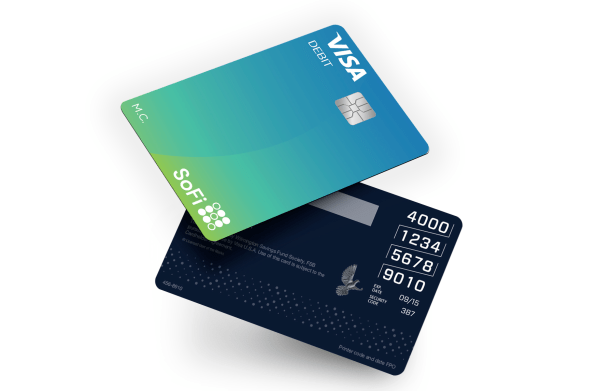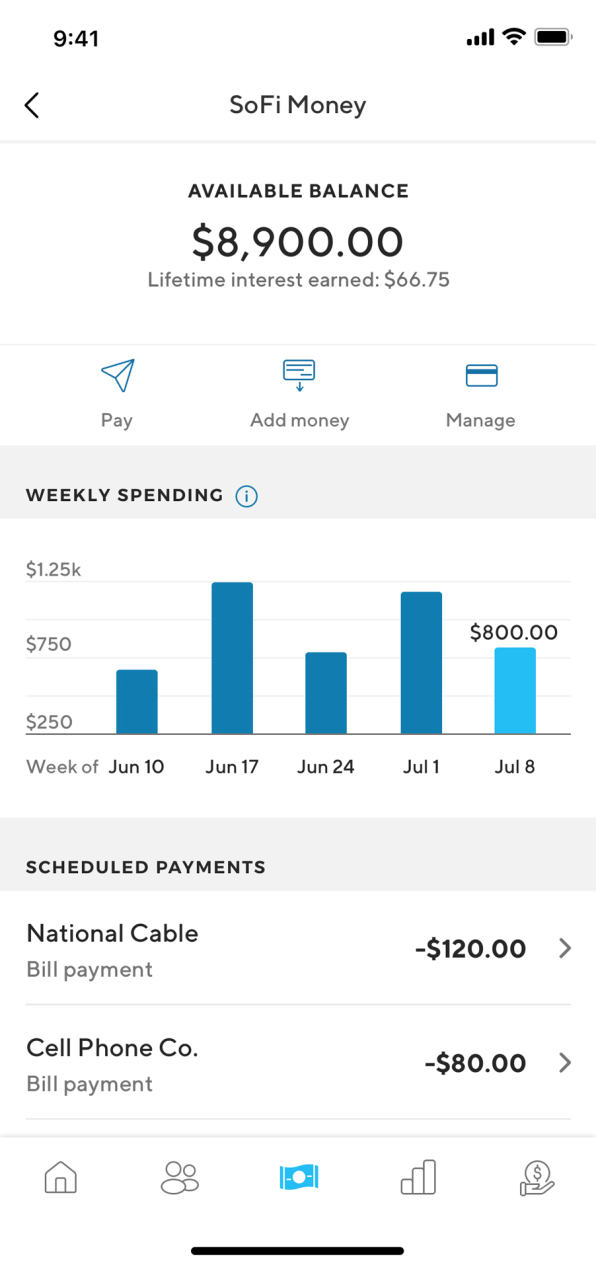Are you ready to ditch your bank? SoFi is betting its future on it
At first glance, SoFi’s banking app, which launches in beta today, is no different from the existing options on the market. It comes with a debit card, enables peer-to-peer payments, and accepts mobile check deposits. The interface, like that of many banking apps, is dominated by a blue-and-white color scheme. But in the details, there is a hint of SoFi’s bigger ambitions. SoFi Money, as the product is known, sets the stage for the fintech company to become both a financial hub and lucrative recommendation engine for its 500,000-plus members.
“This will be the first time that we can bring together a daily product with these more transactional [loan] products and start to build that membership relationship, giving people more value the more they do with us,” says CEO Anthony Noto, a former Twitter executive.
Noto made SoFi Money a top priority when he joined the company in March. At the time, SoFi was in rebuilding mode following the abrupt departure of cofounder Mike Cagney, who resigned last September. Mounting allegations of sexual harassment, verbal harassment, and “frat house” social dynamics had engulfed the fintech unicorn, threatening to derail its early success. Moreover, the company appeared to lack discipline in its product development, with ideas like a dating app and credit card never getting off the ground.

The launch of SoFi Money signals that Noto is taking a more methodical and deliberate approach than his predecessor. The product, which takes the form of a tab within SoFi’s existing mobile app, has been carefully edited in order to focus on users’ primary banking needs: checking their balance, sending money, adding money, and monitoring their weekly spending. Instead of banking jargon like “transfer funds,” SoFi Money simply invites users to “pay a friend” or “pay a bill.”
SoFi Money also includes a number of features designed to appeal to consumers that fit SoFi’s high-earning target demographic. For example, SoFi Money combines checking and savings into a single current account with 1.1% interest, more than quadruple the rate of most big banks. The product also reimburses users for up to six ATM withdrawals per month, including internationally.
“We realize that the hardest thing in the world is to get people to move off their existing bank,” says Tony Morosini, VP of banking. “We had to make sure the product was great and seamless and easy to use.”

A Little Advice . . .
But SoFi Money’s most compelling feature may be its ability to improve the quality of the company’s financial advice and product recommendations. By giving SoFi a window into members’ spending habits, SoFi Money will be better positioned to help them “achieve financial independence and realize their ambitions,” as the company’s Noto-endorsed new mission statement declares.
“We can use machine learning and data analytics to provide you with information about others that are your age and that are in a similar income bracket and what they’re doing from a savings standpoint and from a spending standpoint,” Noto says. “And so we can provide those aggregated benchmarks as ways to educate our member base, and as ways to give our member base recommendations.”
In the six months since SoFi announced the product, “multiple tens of thousands” of people have added their name to the wait list, according to a company spokesperson. (Acorns, a PayPal-backed savings app, attracted 100,000 preorders for its recently announced debit card in less than four days.) A first batch of customers will gain access to SoFi Money today; later in the year, the product will be open to all.

Rammesh Navaneethakrishnan, a Texas resident who refinanced his graduate school loans with SoFi, added his name to the wait list this past spring. “I frankly don’t visit banks physically, I don’t even remember the last time I went,” he says. Since refinancing with SoFi, he has also attended member events and shifted some of his savings to SoFi Wealth. But he’s not planning to ditch his existing bank immediately after gaining access to the updated app. Instead, he plans to manage his accounts side by side, “because I want to figure out the experience over a period of time.”
Convincing members like Navaneethakrishnan to make a clean break with their current bank will be essential for SoFi Money. Without a complete view of a customer’s spending and saving habits, any advice that SoFi Money presents will be based on flawed assumptions. To encourage direct deposit, and a wholesale relationship switch, SoFi Money is offering cash bonuses of $200 upon receipt of a customer’s first paycheck.
SoFi is not alone in recognizing the power of full visibility into a consumer’s balance sheet. Earlier this year, Amazon was in talks with big banks, including JPMorgan Chase, about the possibility of offering a checking account-style product. Challenger banks founded in Europe, including N26 and Revolut, are gearing up for U.S. launches later this year. And among U.S. fintech companies, there has been an explosion of mobile-first banking experiences geared toward lower-income consumers, many of whom lack a bank or would happily leave their traditional bank (and its fees) behind. PayPal falls into this last category, as well as startups MoneyLion and Stash.
For SoFi Money, the most direct competition may come from Marcus, the two-year-old consumer brand operated by Goldman Sachs. Marcus—which, like SoFi, launched as a lending product—acquired personal finance startup Clarity Money and its 1 million customers in April. As Marcus integrates with Clarity, it will adopt Clarity’s open marketplace approach, presenting customers with offers from third-party providers alongside the bank’s own products and services.
Noto plans to rely on third-party providers in some cases as well. “We’re not hard-set that we have to develop every solution,” he says. “We’ve partnered on the insurance side, we’re partnering on career advice right now with Korn Ferry. You’ll continue to see us leverage both owned-and-operated things that we’ve built as well as partnerships to deliver on that complete equation of value for our members.”
Delicate Balancing Act
Convincing customers to buy a second or third SoFi product is central to the company’s strategy. SoFi’s relatively high customer acquisition costs—which Fast Company first reported in March—are more easily justified if the company is able to master the art of the digital cross-sell. To former CEO Cagney, the prospect of using a core banking product to attract new customers and keep existing customers engaged was worth at least $100 million—the price he paid for Zenbanx, which provided the foundational technology for SoFi Money, last February.
The challenge for SoFi, and for its rivals, will be finding the right cadence of recommendations. Get overeager, and customers may sour on the service. Meron Colbeci, SVP of product management, is highly attuned to this concern. “If a company uses this as a way to pump offers into the customer’s stream, they’re going to lose that trust very, very quickly,” he says. “Relevancy and personalization are going to be key.”
If SoFi Money can master that balance, the company, worth $4 billion in its last financing round, may soon be able to get its IPO plans back on track.
Fast Company , Read Full Story
(14)



